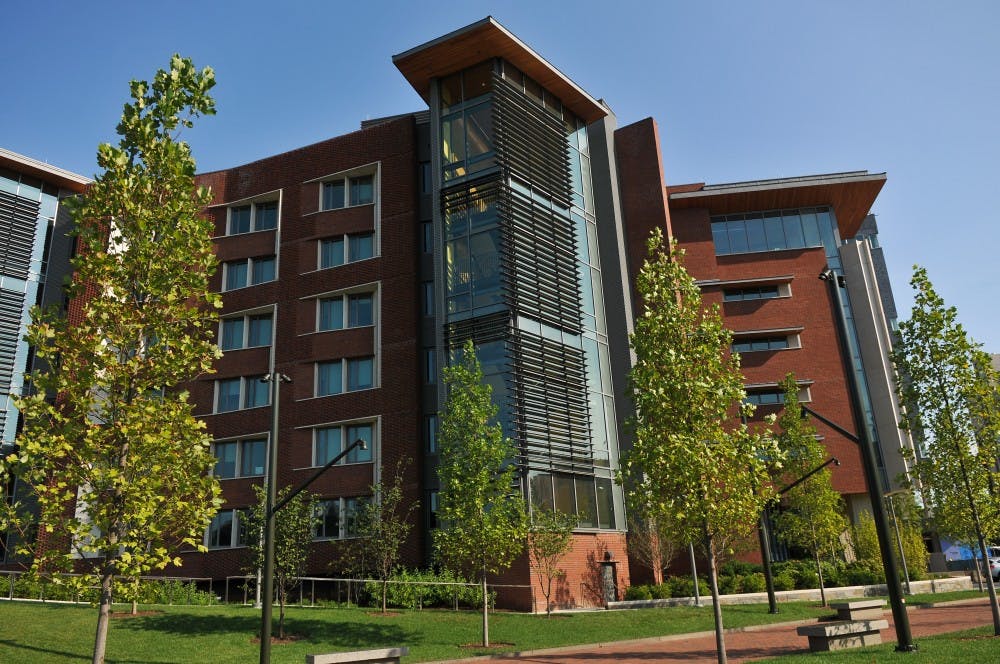Six million square feet of Penn's campus has undergone construction since 2006. But many of these new or renovated buildings, which rarely exceed 20 stories, have taken longer to build than other apartments in University City because of administrative funding delays and complex building structures.
Penn announced plans on Nov. 2 to build New College House West — a residential 13-story building that will cost the University a record-breaking $163 million. The dorm's construction will begin in the spring of 2018 and is expected to open in the fall of 2021, an estimated timeline of three and a half years. At seven stories, New College House is the most recent dorm to open its doors to new students and took two and a half years to construct.
Other University City apartment buildings with far taller structures, however, have taken less time than Penn dorms. The 47-story FMC Tower located at 30th and Walnut streets, one of the tallest buildings in Philadelphia, only took two and a half years to build. Evo Philly, a 33-story luxury residential building on 30th and Chestnut streets, took 19 months to build. The 25-story apartment building at 38th and Chestnut streets was also built in under two years after it broke ground in the fall of 2013.
One reason that Penn dorms can take decades to begin construction is administrative delays.
Eero Saarinen, the architect of Hill College House, proposed the idea of NCH in 1958, far before it was officially approved. Hill was originally conceived to be one of two buildings, said University Architect David Hollenberg.
But over 50 years passed before ground was broken in 2013 for NCH because administrators had not yet identified the need for a new residential building. Hollenberg said identifying a need for a new building is a “powerful fundraising tool." After funding was secured, he headed a committee along with Provost Vincent Price to hire an architect.
Hollenberg also said that the ideas for most of the new buildings, including NCH, Levin Building, Perry World House, and the Perelman Center for Political Science and Economics, have often been planned for decades.
Although the construction of NCHW was announced earlier this month, the University held a design competition in 1999 for architects to propose plans for the building. No further actions materialized because of funding delays, Executive Director for Penn Business Services Douglas Berger said.
RELATED:
Penn just approved its third housing project in four years. But is another dorm necessary?
Penn announces plans for a new residential building at 40th and Walnut streets
All Penn construction projects until 2030 have been described in Penn Connects, an architectural blueprint put forth in 2006, recommending the University’s future projects be committed to sustainability, engagement with Philadelphia, and further integrating Penn’s undergraduate schools.
Another factor that administrators cite as an explanation for the long timeframe is that structures of some Penn dorms like NCH are extremely complex and take longer to construct.

More than 650,000 bricks were hand-laid for NCH, and each part of the building is distinct, with multiple roofs, a dining hall, communal kitchens, bedrooms, and study spaces, said Michael Dausch, executive director of design and construction management for Penn's Facilities and Real Estate Services. For buildings like Evo, the structure is less complex and easier to assemble.
“If you look at the Evo building, it’s a rectangular building, very uniform, and the exterior of it is big [and] pre-fabricated, “ Dausch said. Cranes lift up and attach the pre-made walls, and each of the apartment units inside is structurally the same.
Buildings like Evo, constructed by private real estate developers, are built to last for only 25 years, so they can make a profit and then be either torn down or renovated, Berger said.
In contrast, Penn designs its buildings to last between 50 and 100 years and expects maintenance to complete a lot of replacement and repair work that otherwise might lead to demolition and rebuilding, said Executive Director of Real Estate Ed Datz.
Administrators cited Hill as an example of how Penn dorms are designed to be renovated, rather than reconstructed. Originally completed as a female-only dorm, Hill underwent 15 months of renovation beginning in May 2016. The new club rooms, the addition of air conditioning, and the remodeled bathrooms were constructed to modernize the 550-bed dorm, which The New York Times had named one of the top five worst college dorms in 2015.



